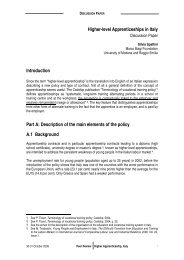The Active Labour Market Policy Reform – The Second Wave
The Active Labour Market Policy Reform – The Second Wave
The Active Labour Market Policy Reform – The Second Wave
You also want an ePaper? Increase the reach of your titles
YUMPU automatically turns print PDFs into web optimized ePapers that Google loves.
May 13-14, 2004<br />
EXECUTIVE SUMMARY<br />
including the North African cities of Ceuta and Melilla. Another problem of the Spanish PES<br />
is that only a small number of the vacancies are registered in the PES. Filling most<br />
vacancies takes place ‘unofficially’ through personal contacts between employees and<br />
employers or other methods. Increasing labour market mobility within the country is also a<br />
big challenge for Spain.<br />
Regarding transferability, it can be said that the Finnish reforms are highly relevant to Spain<br />
but difficult to apply in practice due to the decentralised nature and lack of coordination<br />
between labour market actors in Spain. However, the differentiation between customers, and<br />
the holistic approach to fulfilling the needs of the most hard-to-place customers were seen<br />
as key issues of great relevance to Spain. <strong>The</strong> Spanish independent expert saw the<br />
necessity of returning to the social dialogue among the social partners and government,<br />
visible in the Finnish reforms, as one of the key factors in developing the Spanish labour<br />
market policies.<br />
United Kingdom<br />
A reform of the public employment services has been taking place in the UK in recent years<br />
and there are a number of similarities between the UK situation and the Finnish situation.<br />
Both countries suffer from the co-existence of skill or labour shortages and pockets of high<br />
unemployment or inactivity. While the unemployment figures are relatively low in the UK at<br />
4.8% of the workforce in January 2004, there are large numbers of people who are<br />
‘economically inactive’. <strong>The</strong> employment rate in the UK was 74.8% in January 2004. <strong>The</strong><br />
skills shortages manifest themselves in recruitment difficulties and in a reduction in firms’<br />
competitiveness. <strong>The</strong> main policy developments in the UK have been the New Deal<br />
programme, the Neighbourhood Renewal programme and Local Strategic Partnerships, the<br />
merging of the Employment Service and the Benefits Agency to form the Jobcentre Plus,<br />
and the Skills Strategy.<br />
In terms of transferability, the LAFOS bear a resemblance to the Jobcentre Plus model. <strong>The</strong>y<br />
are interesting for the UK because they focus on the hard-to-reach which are a key target<br />
group of UK labour market policy. <strong>The</strong>ir multi-agency and partnership approach is also of<br />
interest to the UK in that it reflects the different needs of the hard-to-place and the fact that<br />
the PES is only one of the many services needed by this group. While Jobcentre Plus and<br />
other programmes such as the neighbourhood renewal programme and the local strategic<br />
partnerships have been successful in developing co-operation between various actors, the<br />
establishment of LAFOS type centres may enhance such developments. However, such<br />
initiatives would have to take the complex institutional and financial context in the UK into<br />
account and be more flexible.<br />
Further aspects of the Finnish policy which may be of interest to the UK are the full<br />
introduction of e-services for employers and the experimental net-CV service.<br />
Peer Review <strong>The</strong> <strong>Active</strong> <strong>Labour</strong> <strong>Market</strong> <strong>Policy</strong> <strong>Reform</strong> <strong>–</strong><br />
<strong>The</strong> <strong>Second</strong> <strong>Wave</strong><br />
15





